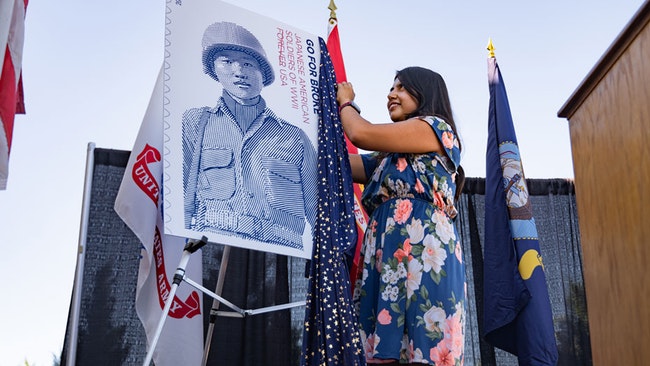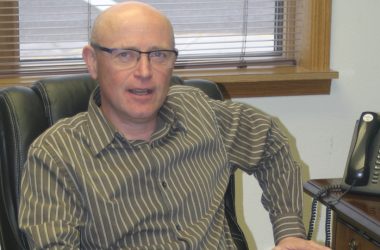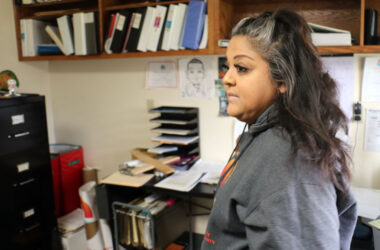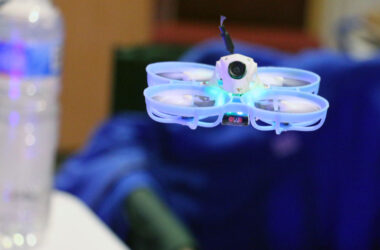
Tanya Navarrete, the former marketing & development director at Four Rivers Cultural Center, unveils the new “Go for Broke” stamp made in honor of the U.S. Army’s 442nd Regimental Combat Team made up of Japanese-American soldiers who fight in Europe in World War II. (ANGELINA KATSANIS/The Enterprise)
ONTARIO – Tom Kamimae’s life changed forever on a lazy, Sunday afternoon in December 80 years ago.
Kamimae’s parents were prepared to go see a movie in Sumner, Wash., when a neighbor walked over to their house.
“He goes ‘The movie is canceled. And we’re at war,” said Kamimae.
The day was Dec. 7, 1941, and the news the Japanese Imperial Navy bombed Pearl Harbor was arcing across the nation.
Kamimae and his family eventually ended up in an internment camp in southern Idaho and he was drafted for military service when he turned 18.
His service and the sacrifice of thousands of Japanese Americans was the focal point of a special ceremony June 14 at Four Rivers Cultural Center.
Kamimae was joined by other local Japanese American veterans, Jim Mizuta and Terou Yano.
The event at the Hikaru Mizu Japanese Garden honored Japanese American service members and the members of the 442nd Regimental Combat Team. Part of the ceremony was the unveiling of the “Go for Broke” commemorative postage stamp that notes the experience of Japanese American service members during World War II.
The 442nd is the most decorated unit of its size in American military history. The unit, made up almost entirely of Japanese Americans who were drafted or joined from internment camps, earned more than 18,000 awards. The Medal of Honor was awarded to 21.
About 33,000 Japanese Americans served during World War II. More than 800 were killed in action.
Ontario resident Tom Greco, one of the organizers of the event, said the men of the 442nd were special.
“They were magnificent soldiers,” said Greco.
The saga of the 442nd is especially poignant because its members were drawn from internment camps across the U.S. After the attack on Pearl Harbor, President Franklin Roosevelt ordered all people of Japanese ancestry away from the west coast.
Kamimae was a sophomore in high school when he and his family were forced to leave their home and travel by foot four miles to the fairgrounds in Puyallup, Wash., as part of the relocation.
From there, Kamimae and his family were shipped to the Minidoka War Relocation Center near Twin Falls, Idaho.
“The government treated us like an enemy but we were all Americans,” said Kamimae.
About two-thirds of the Japanese held at the Minidoka camp were born American. The rest, mostly older folks, were not naturalized citizens.
“I didn’t feel like I was Japanese. I felt like I was an American,” said Kamimae. Later in the war, some Japanese Americans were able to participate in work-release programs and Kamimiae ended up in Ontario when he was 17.
“I registered for the draft in Ontario. First month after I registered I got called for a physical in Boise,” said Kamimae.
Kamimae said he was eventually drafted and sent to a training camp in Florida. He and his fellow trainees were scheduled to go to Europe as replacements for the 442nd.
The war ended before Kamimae finished training but he said he was sent to Europe anyway. There he guarded military installations. Kamimae said he was honored to serve his country, despite the fact he and his family had been put in the Twin Falls camp.
That dichotomy is at the core of the book “Facing the Mountain: A True Story of Japanese American Heroes in World War II,” by author Daniel James Brown.
The book traces the journey of four Japanese Americans men, including three who served in the military, who were caught up in the war.
For many in the internment camps, a chance to serve in the military was a chance to make a statement.
“They felt their loyalty was being questioned and they wanted to prove their loyalty,” Brown said an in an interview. “Others felt that, well if they fought and bled and died on the battlefield maybe things would get better for their Japanese American parents in general,” said Brown.
Brown said his research showed many Japanese American fathers took their sons aside before they departed for war.
“They said ‘Do your best and I hope you come back. But whatever you do don’t bring shame on the family.’ That is a very Japanese notion, even these guys who were thoroughly American, it was part of their makeup,” said Brown.
Brown said that “contributed to their extraordinary valor on the battlefield.”
“They didn’t want to dishonor their family,” said Brown.
Cathy Yasuda, executive director of the Treasure Valley Community College Foundation, who helped organize the cultural center event, agreed.
Her father, George Maeda, served in the 442nd but initially wasn’t interested in serving a nation that placed him in what was essentially a prison camp.
Yasuda said her mother told her that when recruiters arrived at the Minidoka camp, her father and his brother were astonished.
“Him and his brother were like, ‘Are you kidding me? You have us behind barbed wire with guards,’” said Yasuda.
Yasuda said her grandparents stepped in.
“His folks told them you are going to do this and you are going to prove you are an American and proud to be an American citizen,” said Yasuda.
In later years, Yasuda said her father was “very, very proud that he served his country.”
News tip? Contact Pat Caldwell at [email protected]
SAFEGUARD YOUR LOCAL NEWS
Take one action today to help the Enterprise grow and do more for the community through accurate, fair reporting.
SUBSCRIBE: A monthly digital subscription is $5 a month.
GIFT: Give someone you know a subscription.
ONE-TIME PAYMENT: Contribute, knowing your support goes towards more local journalism you can trust.




